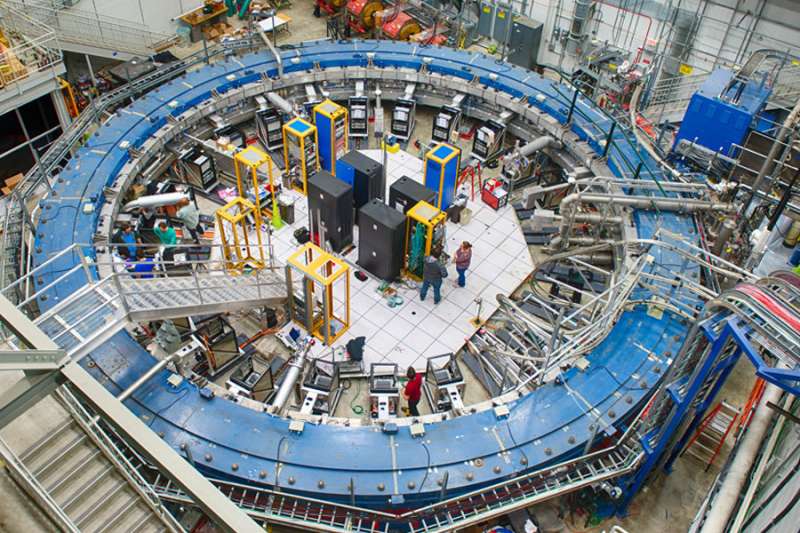Muons spin tales of undiscovered particles

Scientists at U.S. Department of Energy (DOE) national laboratories are collaborating to test a magnetic property of the muon. Their experiment could point to the existence of physics beyond our current understanding, including undiscovered particles.
The experiment follows one that began in 1999 at the DOE's Brookhaven National Laboratory in which scientists measured the spin precession of the muon—i.e., the speed at which its spin changes direction—to be different from the theoretical predictions. Scientists from Argonne National Laboratory and Fermi National Accelerator Laboratory, along with collaborators from more than 25 other institutions, are recreating the experiment with much higher precision to confirm or disprove the former earlier results.
The muon is like the (very) big brother of the electron; they have the same charge, but the muon is over 200 times more massive. The two also share the same spin, a quantum mechanical property that determines a particle's behavior in the presence of a magnetic field.
Particles with spin act like tiny magnets, and when placed in a magnetic field, their spins change direction in a circular motion, much like a spinning gyroscope. The speed of a particle's spin precession is determined by a quantity known as its g-factor, which depends on the particle's spin and the strength of the magnetic field in which it moves.
In modern quantum mechanical theories, the vacuum is not empty. It is full of bubbles of so-called virtual particles, appearing and disappearing very quickly. Interactions between these virtual particles and a real particle, like the muon, can change how the real particle interacts with the magnetic field, affecting its g-factor. Theoretical physicists have calculated, based on our current understanding of the fundamental structure of nature, all the ways that each known particle affects the muon's g-factor, but the measurements that Brookhaven scientists took differed from what they expected by a few parts per million. This difference, if it persists in the new experiment, would point to completely new physics—an exciting discovery for particle physicists.
"If there is actually a discrepancy between the predicted and measured values, it is further proof that the Standard Model, our current understanding of the contents of the universe, is incomplete," said Argonne physicist Peter Winter. "The unexpected effect could be due to an undiscovered particle."
In the new experiment, sited at Fermilab, a beam will travel in a circle through a large, hollow ring due to the presence of a strong magnetic field. The same magnetic field will also lead to the precession of the muon spins while they circle around the ring. The scientists can calculate the g-factor by detecting the spin precession of the muons and knowing the magnetic field strength in the ring.
To achieve the desired precision, both the spin precession frequency and the strength of the magnetic field have to be measured with uncertainties below 70 parts per billion. The research group at Argonne has taken responsibility for measuring the magnetic field to such high precision. "The game of our experiment is to control any systematic uncertainty that could distort our precise measurements," said Winter.
This level of precision requires very sensitive probing devices that the scientists calibrated using highly stable and isolated fields produced by recycled magnetic resonance imaging machines at Argonne.
Once they calibrated the probes, the scientists placed 17 of them on a circular trolley that moves about the ring at Fermilab. The trolley measures the field at around 10,000 points, creating a map of the field strength everywhere in the ring. The trolley rests on two rails running along the sides of the tube, and the scientists move the trolley around the ring using two cables attached to motorized spools.
"This trolley has to move in a vacuum," said Ran Hong, an Argonne postdoctoral appointee on the study, "so to both control its motion and receive the data from the probes is very challenging."
To disturb the field as little as possible, only a single insulated signal cable connects the trolley to the outside world. This cable sends information to the trolley to guide it around the loop, and it sends the data from the probes back to the control room.
The older system used at Brookhaven for that laboratory's experiment sent the information using an analog signal, but Argonne scientists and engineers have digitized the signal to increase the amount of data obtained. "The access to more raw data allows for better analysis, and it has led to a 10-fold increase in precision," said Winter.
Because of the larger digital data set, the cable can only send information in one direction at a time. "We have to flip-flop between sending the trolley instructions and receiving the data," said Hong. "Around every 20 milliseconds, the direction switches."
The scientists have been setting up the Muon g-2 experiment for six years. This year, they will begin to take official data. The experiment will run for months, measuring the spin precession of approximately a trillion muons. Every two to three days, the experiment will pause to allow the trolley to measure the field, and smaller probes on the outside of the vacuum chamber will estimate the field at all times while the experiment runs.
"Unlike large-scale experiments that attempt to detect unknown particles directly, our approach is to search for indirect effects that change something at a very small scale," said Winter. "By very precisely measuring this factor, we can infer whether or not there is something new."
If the new data confirm the previous measurement, the scientists plan to conduct the experiment with even higher precision. Analysis of these new data could give a flavor of the nature of the new physics, and could indicate what detector would have to be constructed to observe the potential new particles directly.
Provided by Argonne National Laboratory





















